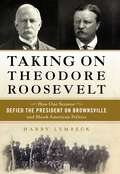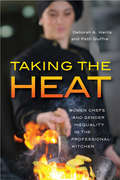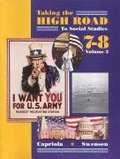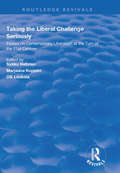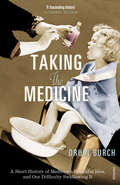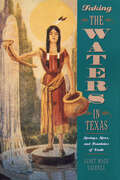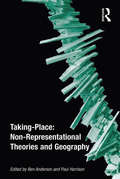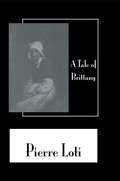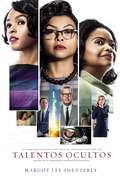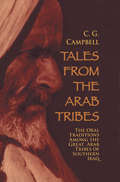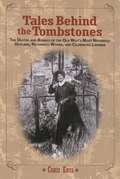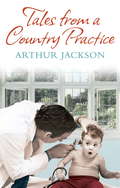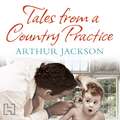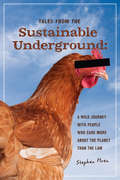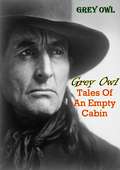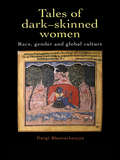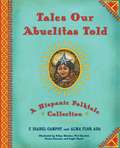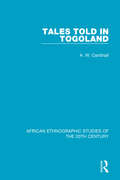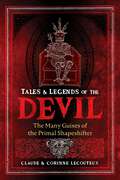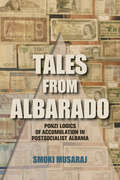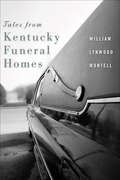- Table View
- List View
Taking on Theodore Roosevelt: How One Senator Defied the President on Brownsville and Shook American Politics
by Harry LembeckIn August 1906, black soldiers stationed in Brownsville, Texas, were accused of going on a lawless rampage in which shots were fired, one man was killed, and another wounded. Because the perpetrators could never be positively identified, President Theodore Roosevelt took the highly unusual step of discharging without honor all one hundred sixty-seven members of the black battalion on duty the night of the shooting. This book investigates the controversial action of an otherwise much-lauded president, the challenge to his decision from a senator of his own party, and the way in which Roosevelt's uncompromising stance affected African American support of the party of Lincoln. Using primary sources to reconstruct the events, attorney Harry Lembeck begins at the end when Senator Joseph Foraker is honored by the black community in Washington, DC, for his efforts to reverse Roosevelt's decision. Lembeck highlights Foraker's courageous resistance to his own president. In addition, he examines the larger context of racism in the era of Booker T. Washington and W.E.B. Du Bois, pointing out that Roosevelt treated discrimination against the Japanese in the West much differently. He also notes often-ignored evidence concerning the role of Roosevelt's illegitimate cousin in the president's decision, the possibility that Foraker and Roosevelt had discussed a compromise, and other hitherto overlooked facts about the case. Sixty-seven years after the event, President Richard Nixon finally undid Roosevelt's action by honorably discharging the men of the Brownsville Battalion. But, as this thoroughly researched and engrossing narrative shows, the damage done to both Roosevelt's reputation and black support for the Republican Party lingers to this day.
Taking the Heat
by Deborah A. Harris Patti GiuffreA number of recent books, magazines, and television programs have emerged that promise to take viewers inside the exciting world of professional chefs. While media suggest that the occupation is undergoing a transformation, one thing remains clear: being a chef is a decidedly male-dominated job. Over the past six years, the prestigious James Beard Foundation has presented 84 awards for excellence as a chef, but only 19 were given to women. Likewise, Food and Wine magazine has recognized the talent of 110 chefs on its annual "Best New Chef" list since 2000, and to date, only 16 women have been included. How is it that women--the gender most associated with cooking--have lagged behind men in this occupation? Taking the Heat examines how the world of professional chefs is gendered, what conditions have led to this gender segregation, and how women chefs feel about their work in relation to men. Tracing the historical evolution of the profession and analyzing over two thousand examples of chef profiles and restaurant reviews, as well as in-depth interviews with thirty-three women chefs, Deborah A. Harris and Patti Giuffre reveal a great irony between the present realities of the culinary profession and the traditional, cultural associations of cooking and gender. Since occupations filled with women are often culturally and economically devalued, male members exclude women to enhance the job's legitimacy. For women chefs, these professional obstacles and other challenges, such as how to balance work and family, ultimately push some of the women out of the career. Although female chefs may be outsiders in many professional kitchens, the participants in Taking the Heat recount advantages that women chefs offer their workplaces and strengths that Harris and Giuffre argue can help offer women chefs--and women in other male-dominated occupations--opportunities for greater representation within their fields. Click here to access the Taking the Heat teaching guide (http://rutgerspress.rutgers.edu/pages/teaching_guide_for_taking_the_heat.aspx).
Taking the High Road to Social Studies 7-8 Volume 2: Reconstruction To The Present
by Arlene Capriola Rigmor SwensenWe deeply appreciate the help so willingly given by many people. In particular, we wish to express our debt and gratitude to Josephine Imwalle, Social Studies Coordinator to the Northport East North School District in New York, for her guidance and expertise;
Taking the Land to Make the City: A Bicoastal History of North America (Lateral Exchanges: Architecture, Urban Development, and Transnational Practices)
by Mary P. RyanThis historical study shows how San Francisco and Baltimore were central to American expansion through the eighteenth and nineteenth centuries. The history of the United States is often told as a movement westward, beginning at the Atlantic coast and following farmers across the continent. But early settlements and towns sprung up along the Pacific as well as the Atlantic, as Spaniards and Englishmen took Indian land and converted it into private property. In this ambitious study of historical geography and urban development, Mary P. Ryan reframes the story of American expansion. Baltimore and San Francisco share common roots as early coastal trading centers immersed in the international circulation of goods and ideas. Ryan traces their beginnings back to the first human habitation of each area, showing how the juggernaut toward capitalism and nation-building could not commence until Europeans had taken the land for city building. She then recounts how Mexican ayuntamientos and Anglo-American city councils pioneered a prescient form of municipal sovereignty that served as both a crucible for democracy and a handmaid of capitalism. Moving into the nineteenth century, Ryan shows how the citizens of Baltimore and San Francisco molded the shape of the modern city: the gridded downtown, rudimentary streetcar suburbs, and outlying great parks. This history culminates in the era of the Civil War when the economic engines of cities helped forge the East and the West into one nation.
Taking the Liberal Challenge Seriously: Essays on Contemporary Liberalism at the Turn of the 21st Century (Routledge Revivals)
by Marjaana Kopperi Sirkku Hellsten Olli LoukolaFirst published in 1997, this collection offers a critical view of modern liberal theory and attempts to present some signposts that could show a way towards a new form of liberal individualism. The first part takes a look at the theoretical aspects of contemporary liberalism. It analyses certain classics whose ideas have once again become central to the new formulation of liberal theory. The second part brings the discussion from theory to practice and to actual policies adopted in liberal Western welfare states. Its main interest is in the economic doctrines which have formed an essential part of classical liberal thought. The third part moves yet another step further in its analysis of contemporary liberal challenges. It concentrates on the problems of the liberal requirement of freedom, neutrality and tolerance.
Taking the Measure of Work: A Guide to Validated Scales for Organizational Research and Diagnosis
by Dail L. FieldsThis book is a handbook for people who want to assure the use of reliable and valid questionnaires for collecting information about organizations. It significantly reduces the time and effort required for obtaining validated multi-question measures of aspects of organizational 'health' such as employee job satisfaction, organizational commitment, organizational justice, and workplace behaviors. It helps users in measuring some factors underlying employee perceptions of work such as job characteristics, role ambiguity or conflict, job stress, and the extent to which employees believe their values and those of the organization are congruent. All the measures in the book have been used and tested in research studies published in the 1990's. <p><p>In addition, all the measures describe the extent and types of reliability and validity tests that have been completed, a feature that organizational researchers should find particularly useful. All in all, this book is a handy tool to increase the efficiency of researchers, consultants, managers, or organizational development specialists in obtaining reliable and valid information about how employees view their jobs and organizations.
Taking the Medicine: A Short History of Medicine’s Beautiful Idea, and our Difficulty Swallowing It
by Druin BurchDoctors and patients alike trust the medical profession and its therapeutic powers; yet this trust has often been misplaced. Whether prescribing opium or thalidomide, aspirin or antidepressants, doctors have persistently failed to test their favourite ideas - often with catastrophic results. From revolutionary America to Nazi Germany and modern big-pharmaceuticals, this is the unexpected story of just how bad medicine has been, and of its remarkably recent effort to improve. It is the history of well-meaning doctors misled by intuition, of the startling human cost of their mistakes and of the exceptional individuals who have helped make things better. Alarming and optimistic, Taking the Medicine is essential reading for anyone interested in how and why to trust the pills they swallow.
Taking the Village Online: Mothers, Motherhood, And Social Media
by Basden Lorin ArnoldThe rise of social media has changed how we understand and enact relationships across our lives, including motherhood. The meanings and practices of mothering have been significantly impacted by the availability of communities found via forums, blogs, and sites like Twitter, Facebook, and Instagram, as well as internet resources that function to inform maternal experience and self-concept (ex. motherhood websites, Pinterest, or YouTube). The village that now contributes to the mothering experience has grown exponentially, granting mothers access to interactional partners and knowledge never before available. This volume of works explores the impact of social media forms on our cultural understandings of motherhood and the ways that we communicate about the experience and practice of mothering.
Taking the Waters in Texas: Springs, Spas, and Fountains of Youth
by Janet Mace ValenzaThis historical study reveals a fascinating yet forgotten aspect of life in nineteenth century Texas—its once-famous mineral spring health spas. Southern Texas once boasted an enviable variety of mineral waters. Though most are closed and nearly forgotten today, Texas spas and resorts once drew thousands of visitors from across the country. They came seeking rejuvenation of body and spirit in the healing mineral waters. This book offers the first comprehensive history of Texas&’ healing springs. Janet Valenza tracks the rise, popularity, and decline of the "water cure" from the 1830s to the present day. She follows the development of major spas and resorts, such as Mineral Wells and Indian Hot Springs near El Paso, as well as smaller, family-run springs. Valenza also describes how mineral waters influenced patterns of settlement, transportation routes, commerce, and people&’s attitudes toward the land. Period photos and quotes from those seeking cures offer vivid glimpses into the daily life at the springs, which Valenza lists and describes county-by-county in the appendix.
Taking-Place: Non-representational Theories And Geography
by Ben AndersonEmerging over the past ten years from a set of post-structuralist theoretical lineages, non-representational theories are having a major impact within Human Geography. Non-representational theorisation and research has opened up new sets of problematics around the body, practice and performativity and inspired new ways of doing and writing human geography that aim to engage with the taking-place of everyday life. Drawing together a range of innovative contributions from leading writers, this is the first book to provide an extensive and in-depth overview of non-representational theories and human geography. The work addresses the core themes of this still-developing field, demonstrates the implications of non-representational theories for many aspects of human geographic thought and practice, and highlights areas of emergent critical debate. The collection is structured around four thematic sections - Life, Representation, Ethics and Politics - which explore the varied relations between non-representational theories and contemporary human geography.
Tale Of Brittany
by LotiFirst Published in 2002. Routledge is an imprint of Taylor & Francis, an informa company.
Talentos ocultos: La genialidad no tiene color. La fuerza
by Margot Lee ShetterlyLa fenomenal historia de mujeres matemáticas afroamericanas de la NASA en la vanguardia del movimiento feminista y de derechos civiles, cuyos cálculos impulsaron uno de los mayores logros espaciales de Estados Unidos. Pronto será una gran película protagonizada por Taraji P. Henson, Octavia Spencer, Janelle Monae, Kirsten Dunst, y Kevin Costner. Antes de que John Glenn girara en órbita alrededor de la Tierra, o Neil Armstrong caminara en la luna, un grupo de mujeres profesionales en el área de las matemáticas conocidas como «computadoras humanas» usaron lápices, reglas de cálculo, máquinas de sumar para escribir las ecuaciones base para el lanzamiento de cohetes y astronautas al espacio. Entre ellas se encuentran un grupo de mujeres afroamericanas excepcionalmente talentosas, algunas de las mentes más brillantes de su generación. Originalmente relegadas a enseñar matemáticas en escuelas públicas segregadas del sur, fueron llamadas a servir durante la escasez laboral de la Segunda Guerra Mundial, cuando la industria aeronáutica de Estados Unidos se encontraba en extrema necesidad de alguien con conocimientos. Repentinamente, estas profesionales tenían acceso a un empleo digno de sus habilidades y respondieron al llamado del Tío Sam, se mudaron a Hampton, Virginia, y al fascinante mundo del Laboratorio Aeronáutico Langley Memorial. Iniciando en la Segunda Guerra Mundial y hasta la Guerra Fría, el Movimiento de los derechos civiles y la carrera espacial, Figuras ocultas entrelaza las historias de Dorothy Vaughan, Mary Jackson, Katherine Johnson y Christine Darden, cuatro mujeres afroamericanas que participaron en algunos de los mayores éxitos de la NASA. Es la crónica de sus carreras a lo largo de casi tres décadas en las que enfrentaron desafíos, alianzas y utilizaron su intelecto para cambiar sus vidas y el futuro de su
Tales Arab Tribes
by BucklandFirst published in 2007. Routledge is an imprint of Taylor & Francis, an informa company.
Tales Behind the Tombstones: The Deaths and Burials of the Old West's Most Nefarious Outlaws, Notorious Women, and Celebrated Lawmen
by Chris EnssA crumbling headstone in the cemetery at Bodie,California, memorializes Rosa May, a prostitute still known for caring for the sick. In Deadwood, South Dakota, Calamity Jane and Wild Bill Hickok, infamous to the end, lie interred side by side, per Jane's last request. And at the top of Lookout Mountain in Colorado lies the greatest western showman of all time, Buffalo Bill Cody, his grave site visited by thousands every year.
Tales From A Country Practice
by Dr Arthur JacksonWhen the phone rings in the middle of the night, Dr Arthur Jackson leaves the warmth of his bed without hesitation. Tending to his peculiar flock of patients - including the blind cobbler with a surprising taste for hard liquor, the accident-prone butcher and the young woman with an unusual phobia - is his first priority, whether their illness is critical or they simply need a comforting hand to hold. The whole community turns to the young doctor for advice . . . and not all of it medical.Meanwhile, Dr Jackson's family are settling into their new home, a rambling manor house complete with uncooperative ducks and a ghost. This delightfully nostalgic tale follows their progress as the negotiate the highs and lows, the hilarious ups and downs, of life in a country practice.
Tales From A Country Practice
by Dr Arthur JacksonWhen the phone rings in the middle of the night, Dr Arthur Jackson leaves the warmth of his bed without hesitation. Tending to his peculiar flock of patients - including the blind cobbler with a surprising taste for hard liquor, the accident-prone butcher and the young woman with an unusual phobia - is his first priority, whether their illness is critical or they simply need a comforting hand to hold. The whole community turns to the young doctor for advice . . . and not all of it medical.Meanwhile, Dr Jackson's family are settling into their new home, a rambling manor house complete with uncooperative ducks and a ghost. This delightfully nostalgic tale follows their progress as the negotiate the highs and lows, the hilarious ups and downs, of life in a country practice.
Tales From the Hanging Court
by Tim Hitchcock Robert ShoemakerTales from the Hanging Court draws on published accounts of Old Bailey trials from 1674-1834, a rich seam of social, political and legal history. Through these compelling true stories of theft, murder, rape and blackmail, Hitchcock and Shoemaker capture the early history of the judicial system and the colourful, vibrant and sometimes scandalous world of pre-industrial London: 'This was a time when an orphan could live for a week by stealing a single handkerchief, but be hanged for less; when stocks and pillories were still in use, duels were still fought, and the medieval punishment of 'pressing' to death - spreadeagled on the ground and poled with heavy weights - was still on the statute books; when your jailer could invite you upstairs for a beer or leave you in an airless dungeon with no water on a whim; when you might be murdered in your bed for some linen or a silver tankard ' Time Out In its heyday the court was a soap opera of intrigue, sensation and murky goings on where authors such as Dickens and Defoe would go for inspiration. Thieves and murderers were often caught by members of the public and prosecutions brought by victims. Hitchcock and Shoemaker chart an increasingly sophisticated society taking crime and punishment away from the anarchy of the London mob to put it into a court where a judge and jury meted out justice. The authors paint a vivid picture of a flourishing city where market capitalism and Enlightenment thinking battled to impose order on the chaotic crime that accompanied Britain's economic miracle.
Tales From the Sustainable Underground
by Stephen HrenActivists striving for any type of social change often find themselves operating on the fringes of legal and social norms. Many experience difficulties when their innovative ideas run afoul of antiquated laws and regulations that favor a big business energy- and material-intensive approach. Tales From the Sustainable Underground is packed with the stories of just some of these pioneers-who care more for the planet than the rules-whether they're engaged in natural building, permaculture, community development, or ecologically based art. Ride along and meet courageous and inspiring individuals such as:*Solar guru Ed Eaton*Radical urban permaculturists Scott Kellogg and Stacy Pettigrew*Artist, eco-architect, and intuitive builder Matt BuaEqually entertaining and informative, the profiles in this highly original book provide a unique lens through which to view deeper questions about the societal structures that are preventing us from attaining a more sustainable world. By examining such issues as the nature of property rights and the function of art in society, the author raises profound questions about how our social attitudes and mores have contributed to our current destructive paradigm.Tales From the Sustainable Underground is a must-read for sustainability activists in any field, or for anyone who wants to learn about more radical forms of sustainability activities in an entertaining way.Stephen Hren is a restoration carpenter, builder, and teacher who specializes in sustainable design and passive and active solar heating technologies. He is co-author of The Carbon-Free Home and A Solar Buyer's Guide for the Home and Office.
Tales Of An Empty Cabin
by Grey OwlOriginally published in 1936, this classic collection of Canadian yarns harkens to a simpler time, a time when we were closer to the natural world around us. It is a celebration of the pure delight of storytelling, and of the bounty of the land.Grey Owl was both a hearty outdoorsman and a skilled raconteur, and his stories of life in the bush, so beloved by readers then and now, are the perfect companion for a cold winter night or a lazy summer afternoon. In Tales of an Empty Cabin, he offers an eclectic sampling of campfire stories--some are tall tales, while some are drawn directly from the author's own day-to-day life. All are characterized by Grey Owl's unique wit, charm, and passion of nature.
Tales Of Dark Skinned Women: Race, Gender And Global Culture (Race And Representation Ser.)
by Gargi BhattacharyyaExploring the way race and gender are portrayed in popular culture, this text focuses on the representation of black women. It incorporates a discussion of the politics of representation in Britain and North America, and the shift from negative stereotypes to positive images to postmodern knowingness. The author pays particular attention to the reach of various race/gender literacies, most notably the impact of North American racial discourse on British conceptions of Asian and Afro-Caribbean femininity.
Tales Our Abuelitas Told: A Hispanic Folktale Collection
by Alma Flor Ada F. Isabel CampoyA sly fox, a bird of a thousand colors, a magical set of bagpipes, and an audacious young girl...A mixture of popular tales and literary lore, this anthology celebrates Hispanic culture and its many roots -- Indigenous, African, Arab, Hebrew, and Spanish.
Tales Told in Togoland
by A. W. CardinallOriginally published in 1931, this book collects tales told to the author by agricultural labourers and hunters in what was Togoland in the 1920s. A rare and valuable resource of oral history, the book also contains the history of the Dagomba from Northern Ghana.
Tales and Legends of the Devil: The Many Guises of the Primal Shapeshifter
by Claude Lecouteux Corinne LecouteuxExplores the many forms and abilities of the devil in stories from around the world• Draws on folk traditions from all over Europe, including Transylvanian Romania, Bulgaria, Albania, Switzerland, Italy, France, Scandinavia, and the Baltic countries• Traces the devil&’s shapeshifting powers back to their Vedic origins in ancient India and looks at his connections with witches and storm magic• Reveals how many of the qualities and magical powers attributed to the devil were once those belonging to pagan godsThe devil has many more guises than the cliché red boogeyman named Lucifer or Satan who haunts Christianity. In some traditions the devil is sinister and cunning, while others portray him as an oaf who can easily be conned and evaded by anyone with an ounce of cleverness. In other tales and legends, he is the primal shapeshifter, and the Roma, also known as the gypsies, claimed his talents of metamorphosis were so strong he could even assume the appearance of a priest. Drawing on folk traditions from all over Europe, including Transylvanian Romania, Bulgaria, Albania, Switzerland, Italy, France, Scandinavia, Moravia, Bohemia, Lapland, and the Baltic countries, Claude and Corinne Lecouteux explore the many forms and abilities of the devil in stories, tales, and legends throughout the ages. They trace the devil&’s shapeshifting powers back to their Vedic origins in ancient India and look at his connections with witches, storm magic, and other magical events. They examine the symbolic implications of the appearance of the devil in these tales, such as how he is often either limping or disfigured with the legs or feet of a goat or other animals traditionally linked to the lower powers or passions. They explain how the devil&’s limp or his goat-like feet reflect the prevalence in world mythology of the sacred nature of crippling injuries. Peeling back the Christian veneer embedded in many tales and legends about the so-called Evil One, the authors ultimately reveal how many of the qualities and magical powers attributed to the devil were once those belonging to pagan gods, like the Lithuanian thunder god Perkūnas or the Titan Chronos, as well as to playful woodland spirits and the sometimes helpful, sometimes fearful fauns and satyrs of Greco-Roman mythology.
Tales from Albarado: Ponzi Logics of Accumulation in Postsocialist Albania
by Smoki MusarajTales from Albarado revisits times of excitement and loss in early 1990s Albania, in which about a dozen pyramid firms collapsed and caused the country to fall into anarchy and a near civil war. To gain a better understanding of how people from all walks of life came to invest in these financial schemes and how these schemes became intertwined with everyday transactions, dreams, and aspirations, Smoki Musaraj looks at the materiality, sociality, and temporality of financial speculations at the margins of global capital. She argues that the speculative financial practices of the schemes were enabled by official financial infrastructures (such as the postsocialist free-market reforms), by unofficial economies (such as transnational remittances), as well as by historically specific forms of entrepreneurship, transnational social networks, and desires for a European modernity. Overall, these granular stories of participation in the Albanian schemes help understand neoliberal capitalism as a heterogeneous economic formation that intertwines capitalist and noncapitalist forms of accumulation and investment.
Tales from Kentucky Funeral Homes
by William Lynwood Montell“A unique firsthand record of this history and culture of death in Kentucky relayed nearly word-for-word to preserve the language, style and emotion.” —Hardin Company Historical SocietyIn Tales from Kentucky Funeral Homes, William Lynwood Montell has collected stories and reminiscences from funeral home directors and embalmers across the state. These accounts provide a record of the business of death as it has been practiced in Kentucky over the past fifty years. The collection ranges from tales of old-time burial practices, to stories about funeral customs unique to the African American community, to tales of premonitions, mistakes, and even humorous occurrences. Other stories involve such unusual aspects of the business as snake-handling funerals, mistaken identities, and in-home embalming. Taken together, these firsthand narratives preserve an important aspect of Kentucky social life not likely to be collected elsewhere. Most of these funeral home stories involve the recent history of Kentucky funeral practices, but some descriptive accounts go back to the era when funeral directors used horse-drawn wagons to reach secluded areas. These accounts, including stories about fainting relatives, long-winded preachers, and pallbearers falling into graves, provide significant insights into the pivotal role morticians have played in local life and culture over the years.“A fascinating read . . . Some of the stories are thoughtful explanations of past funeral customs and ruminations on the needs of grieving, but many are also funny.” —Lexington-Herald Leader“Yes, they have humorous stories to tell, but they also have poignant tales that will move you.” —Bowling Green Daily News“[Montell’s] edited anecdotes preserve many of those traditions for readers interested in commonwealth customs related to ‘passing on.’” —Courier-Journal
